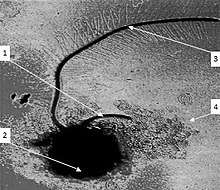Mastigoneme
Mastigonemes are lateral "hairs" on the flagella of stramenopile protists; very similar hairs also occur on flagella of cryptophyte protists.[1] They are approximately 15 nm in diameter, and usually consist of a tubular shaft that itself terminates in smaller "hairs". It is believed that they assist in locomotion by reversing the thrust caused when a flagellum beats. The consequence is that the cell is drawn into the water and particles of food are drawn to the surface of heterotrophic species. More flaccid hairs occur on other protists, such as euglenids.



Typology of flagella with hairs:[2][3][4][5][6]
- whiplash flagella (= smooth, acronematic flagella): without hairs but may have extensions , e.g., in Opisthokonta
- hairy flagella (= tinsel, flimmer, pleuronematic flagella): with hairs (= mastigonemes sensu lato), divided in:
- with fine hairs (= non tubular, or simple hairs): occurs in Euglenophyceae, Dinoflagellata, some Haptophyceae (Pavlovales)
- with stiff hairs (= tubular hairs, retronemes, mastigonemes sensu stricto), divided in:
- bipartite hairs: with two regions. Occurs in Cryptophyceae, Prasinophyceae, and some Heterokonta
- tripartite (= straminipilous) hairs: with three regions (a base, a tubular shaft, and one or more terminal hairs). Occurs in most Heterokonta
Observations of mastigonemes using light microscopy dates from the nineteenth century.[7][8][9][10][11]. Considered artifacts by some, their real existence would be confirmed with electron microscopy.[12]
References
- Hoek, C. van den, Mann, D. G. and Jahns, H. M. (1995). Algae : An introduction to phycology, Cambridge University Press, UK.
- Webster & Weber (2007).
- South, G.R. & Whittick, A. (1987). Introduction to Phycology. Blackwell Scientific Publications, Oxford. p. 65, .
- Barsanti, Laura; Gualtieri, Paolo (2006). Algae: anatomy, biochemistry, and biotechnology. Florida, USA: CRC Press. pp. 60-63,
- Dodge, J.D. (1973). The Fine Structure of Algal Cells. Academic Press, London. pp. 57-79,
- Lee, R. E. (2008). Phycology (4th ed.). Cambridge University Press. p. 7, .
- Loeffler, F. (1889). Eine neue Methode zum Färbern der Mikroorganismen, im besonderen ihrer Wimperhaare und Geisseln. Zentralblatt für Bakteriologie und Parasitenkunde, 6, 209–224. .
- Fischer, A. (1894). Über die Geißeln einiger Flagellaten. Jahrbuch für wissenchaftliche Botanik 26: 187-235.
- Petersen, J. B. (1929). Beiträge zur Kenntnis der Flagellatengeißeln. Saertryk af Botanisk Tidsskrift. Bd. 40. 5. Heft.
- Vlk, W. (1931). Uber die Struktur der Heterokontengeisseln. Botanisch Centralblatt 48: 214–220. .
- Deflandre, G. (1934). Sur la structure des flagelles. Annales de Protistologie Vol. IV, pp. 31-54.
- Pitelka, D. R. (1963). Electron-Microscopic Structure of Protozoa. Pergamon Press, Oxford. .